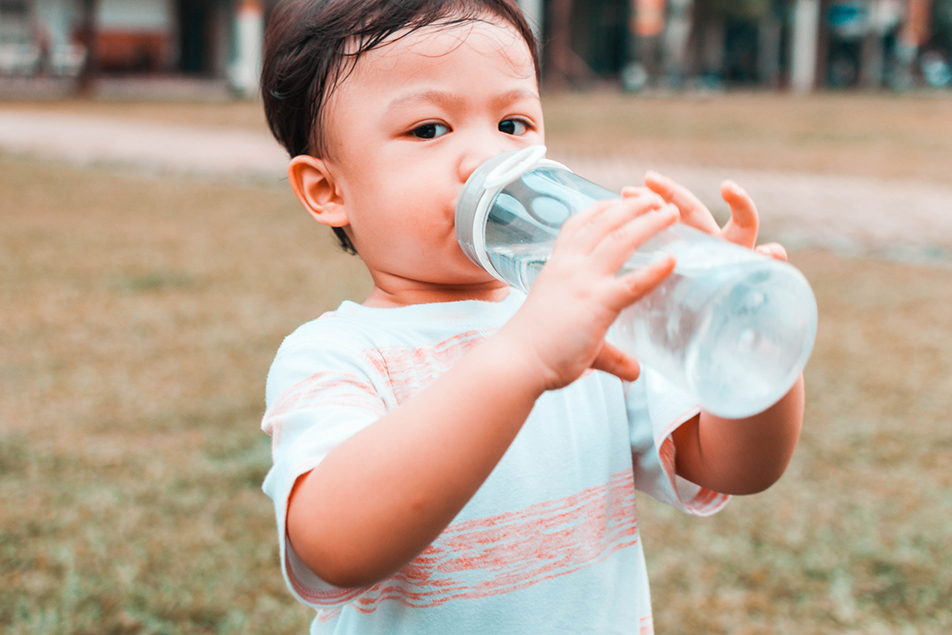
Everyone loses water throughout the day, and most of the time, that loss of fluid is quickly replaced by eating and drinking. However, in some cases, children can lose more water than normal and become dehydrated. Reshma Khatri, MD, PPG – Pediatrics, walks us through the instances in which pediatric dehydration can occur, the signs parents should watch for and what steps they can take toward prevention.
What is dehydration?
Dehydration is when there is an imbalance of water content within your body. It occurs when you use or lose more fluid than what you take in from drinking and eating. The body needs a certain amount of water to function properly. If you do not replenish the lost fluid, you will become dehydrated, which can be dangerous, especially for young children.
What are the causes of dehydration in infants and children?
Children can become dehydrated for simple reasons like taking in less fluids (eating or drinking) because of an upset stomach or sore throat. But, other causes of dehydration could also include:
- Fever
- Vomiting
- Diarrhea
- Excessive sweating
- Increased urination due to problems or medicines
Additionally, there are also different degrees of dehydration. Mild dehydration is not life-threatening but does require treatment. However, if mild dehydration goes untreated, it can worsen. Severe dehydration is a medical emergency and can be life-threatening.
What are the signs and symptoms of dehydration in children?
While the signs and symptoms of dehydration can differ by age, the most common signs in children can include:
- No tears when crying
- Dark or yellow urine in early stages
- Dry mouth and tongue with less saliva
- Headaches and increased thirst
- Sunken eyes, cheeks, and soft spot (on top of the skull)
- Irritability, listlessness and/or decreased activity for age (mild cases)
- Lethargy and/or sleepiness with difficulty rousing (severe cases)
- No urine or wet diapers for three hours in babies
- No urine for 4-6 hours in young children and 6-8 hours in older children
Additionally, some of the more complex signs of dehydration, like an increased heart rate, low blood pressure and electrolyte changes, may be harder to notice and only be detected by a doctor.
How is pediatric dehydration treated?
Parents and caregivers must know the early warning signs of dehydration, so they can respond quickly if their child presents with it. The goal for treating dehydration is to replace any lost fluid and restore the body’s levels to normal.
While the early stages and mild signs of dehydration can easily get treated at home, it’s best to speak with your pediatrician to ensure the following steps are appropriate for your child:
- Utilize a replacement liquid: An oral rehydration solution like Pedialyte® has the correct ratio and combination of carbohydrate to electrolytes, which will help maintain glucose and electrolyte levels in the blood, in addition to hydration. With that said, parents should encourage about 1 teaspoon of solution every few minutes instead of 2-3 ounces at a time because too much too fast can induce vomiting.
- Continue to feed: It’s best to continue to breastfeed and/or formula feed if tolerated. Parents may need to use a syringe or spoon to feed their child if they refuse a bottle or cup. Small frequent feeds are always a good option in situations like vomiting/pain with swallowing.
- Avoid certain liquids: If a child has diarrhea, do not use household sports drinks, juices, tea, chicken broth or rice water as this might worsen the loose stools.
- Manage discomfort: Pain management is key to help a child with a sore throat or ear pain feel more comfortable and continue to take in fluids and maintain hydration. Also, be sure to check with your child’s pediatrician to ensure you’re giving them the correct type and dosage of pain medication.
So, the big question, how do you know if your efforts are working? You’ll see the treatment for dehydration is working when your child urinates more often, or your baby has more wet diapers, and their urine looks pale yellow or clear in color.
What are the best ways of preventing dehydration in children?
Parents and caregivers can prevent their child from getting dehydrated and being hospitalized by helping them stay hydrated when sick or physically active and monitoring their intake closely.
Any time your child has an illness that decreases their fluid intake, whether due to pain, fever, loose stools or vomiting, it’s best to have a plan of action to maintain their hydration. I always ask parents to monitor their child’s intake, wet diapers, urination and activity level. It’s important to encourage your child to drink plenty of fluids, especially if they are sick or have a fever. And, as previously mentioned, give your baby or young child an oral rehydration solution as soon as they start vomiting or having diarrhea. It will help lessen the loss of too much body water.
If your child isn’t ill but is active and has outside activities with temperatures of 90 degrees or more, be sure to give your child extra fluids and ensure they take frequent hydration breaks to prevent any heat-related illness.
If your child has diabetes or other endocrine issues, be sure to create a tailored action plan with their pediatrician or physician because they may not present with the same signs or symptoms of dehydration as other children.
When should parents and caregivers be worried or seek medical attention for their child?
If you feel your child has had decreased intake and increased losses, please follow the hydration plan discussed above. However, if you think your child has any more severe dehydration symptoms, your child will need to be seen. If you have questions or need more guidance, please call your pediatrician or primary care provider.



